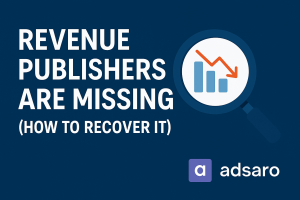In today’s digital advertising landscape, publishers constantly walk a tightrope—maximizing revenue while ensuring a smooth and engaging user experience. At the center of this balancing act lies a crucial element: ad density. The challenge is learning how to balance UX and revenue with ad density in a way that satisfies both business goals and audience expectations.
Show too many ads, and your audience might bounce within seconds. Show too few, and you’re leaving money on the table. So, how do you balance UX and revenue with ad density without alienating your users or sacrificing your monetization goals?
In this guide, we’ll dive deep into what ad density is, why it matters, and how publishers can strike the perfect equilibrium between user satisfaction and consistent ad revenue. Whether you’re a publisher, content creator, or media strategist, this blog is your playbook for smarter monetization.
What Is Ad Density and Why It Matters?
Ad density refers to the proportion of advertising relative to actual content on a webpage. It plays a significant role in both user engagement and monetization performance.
Too many ads can:
- Make the page feel cluttered
- Slow down loading time
- Distract from the main content
- Prompt users to install ad blockers
Conversely, too few ads:
- Undercut your monetization potential
- Lead to missed opportunities from premium placements
- Offer low ROI for your traffic
Knowing how to balance UX and revenue with ad density is crucial because it affects everything from SEO rankings to return visits and brand credibility.
Why Balancing UX and Revenue Is Crucial
Every publisher dreams of maximizing revenue—but not at the cost of alienating their audience. A website overloaded with ads might earn more short-term, but long-term damage is inevitable if users stop coming back.
Here’s why a healthy balance is vital:
- User Experience (UX): A smooth, intuitive journey through your content keeps users engaged and returning.
- Revenue Sustainability: Long-term revenue growth depends on a loyal audience and high-quality impressions.
- Ad Performance: Ads perform better (CTR, viewability, conversions) when they appear in high-quality content environments.
A well-optimized site understands how to balance UX and revenue with ad density by using data-driven decisions, testing, and user feedback.
Best Practices for Optimizing Ad Density
1. Follow Industry Guidelines
Google and other major platforms have strict rules around ad placement—especially on mobile. For example, pages should not display ads that take up more than 30% of the visible screen height.
Why it matters: Violating these guidelines can lead to penalties, demotion in search results, or reduced ad delivery from premium networks.
2. Use Strategic Ad Placement
Ads should be placed:
- Above the fold to capture initial attention, but not overwhelm the visitor.
- In-content (between paragraphs) for higher engagement.
- In sidebars or sticky containers for visibility without obstruction.
Pro tip: Contextual placements (within relevant content) often perform better than banner blindness zones like footers or the very top.
3. Avoid Intrusive Formats
Certain ad formats are more disruptive than others, such as:
- Pop-ups or overlays
- Auto-play video ads with sound
- Full-screen interstitials on mobile
These can lead to poor UX, higher bounce rates, and even manual penalties from Google.
4. Leverage Lazy Loading
Lazy loading ensures ads are only loaded as they become viewable. This reduces initial load time, improves Core Web Vitals scores, and still allows for ad impressions as the user scrolls.
Why it helps: Faster page loads = happier users = better retention and SEO.
5. Test, Measure, Repeat
Use A/B testing to find the best-performing ad layouts, densities, and positions. Monitor:
- Bounce rate
- Scroll depth
- Ad CTR
- Time on page
Tools like Google Optimize, Hotjar, and AdSense Experiments can help evaluate what works best for balancing UX and revenue with ad density.
Use Technology to Automate Balance UX
Modern ad tech offers smarter ways to maintain the UX-revenue balance:
- Header Bidding: Lets you earn more from fewer, high-quality ads.
- Consent Management Platforms (CMPs): Ensure you comply with privacy laws while delivering relevant ads.
- Dynamic Ad Insertion: Tailors ad frequency and type based on user engagement and scroll behavior.
With automation, you can dynamically adjust ad density based on user interaction in real-time—making your ad delivery smarter and less intrusive.
Ensure Compliance and Accessibility
Compliance with advertising standards ensures you’re not just optimizing for revenue, but also protecting your brand. Keep in mind:
- Google Ad Experience Guidelines
- WCAG Accessibility Standards
- Core Web Vitals metrics
- Data privacy laws like GDPR and CCPA
Accessibility and compliance aren’t just legal checkboxes—they’re part of a user-friendly ecosystem that benefits everyone.
Conclusion : Balance UX
Finding how to balance UX and revenue with ad density is not about choosing one over the other—it’s about merging both for sustainable success. Publishers who understand this balance will see better user retention, higher engagement, and stronger long-term ad performance.
Remember:
- Prioritize user-first design
- Use ad placements strategically
- Avoid intrusiveness
- Test everything
- Follow compliance guidelines
With the right approach, you can build a monetization model that supports both your audience and your ad revenue goals—proving that you don’t have to sacrifice experience for income.








Leave a Reply